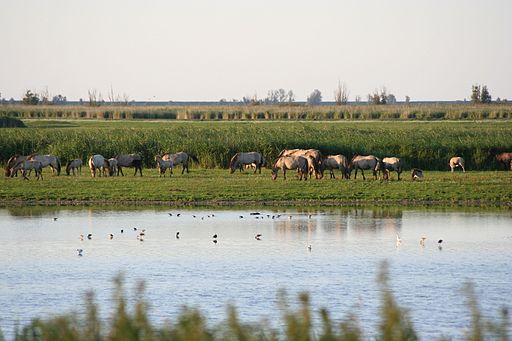Half of the “saved” Konik horses to be killed after all

Animal protection organisations have criticised a decision by the Dutch forestry commission (Staatsbosbeheer) to kill 28 of the 55 Konik horses which were moved to the Lauwersmeer in Friesland in September.
The animals were moved from their former home in the Oostvaardersplassen nature reserve near Lelystad following a judicial order because they had been exposed to the greater burdock, a prickly plant that poses a risk to horses.
Friesland proved to be a reluctant host because, the local authorities feared, the horses might prove a threat to agriculture because they may carry seeds of the great burdock in their manes. The Lauwersmeer is currently free of the plant which is difficult to eradicate.
The province had initially given Staatsbosbeheer a deadline of December 1 to come up with an alternative area to house the horses but the organisation has failed to do so.
Not all the horses will be culled. The remaining 24 animals have been given a reprieve and will be allowed to spend the winter in the Lauwersmeer and will, if necessary, be given extra food.
Animal protection organisations are angry that 28 of the animals will have to be slaughtered despite the judge’s decision. “This is no way to treat animals,” animal activist Fenna Swart told the AD. According to Swart, offers from the Netherlands and abroad to accommodate the animals in other nature reserves have been ignored.
Staatsbosbeheer said it had done everything they could to find a place for the animals. “Unfortunately there is no permanent place for the whole herd in the Lauwersmeer. Staatsbosbeheer explored national and international avenues but unfortunately these didn’t work out,” a spokesman told the paper.
Animal protection organisation Dierenbescherming said it believes Staatsbosbeheer did its best but is critical about the culling of animals from the Oostvaardersplassen in general. “We want to see a long-term solution for these animals which limits culling. The growth of the herds will have to be curbed, for instance using birth control measures,” spokesman Niels Kalkman said.
Culling in the Oostvaardersplassen started in 2019 when 1,830 deer on the reserve were shot. More than half the 5,230 deer, ponies and cattle living on the reserve had died in the winter of 2018 – most of which were shot by forestry commission staff because they were starving.
Large mammals were introduced in the reserve in the 1980s and 1990s in what has proved to be a controversial move. Reserve wardens hoped that the deer and ponies would eat young shoots, keeping the area open so it would attract geese and other wetland birds.
Thank you for donating to DutchNews.nl.
We could not provide the Dutch News service, and keep it free of charge, without the generous support of our readers. Your donations allow us to report on issues you tell us matter, and provide you with a summary of the most important Dutch news each day.
Make a donation